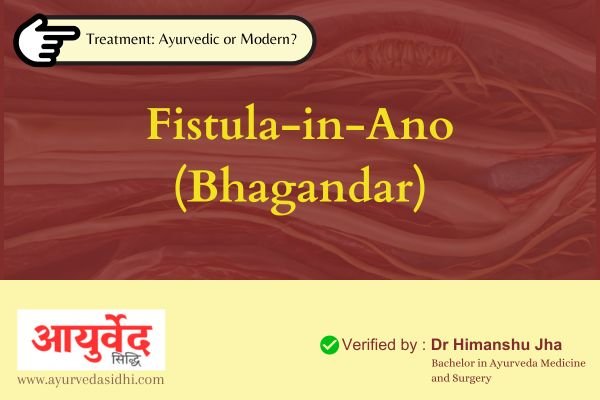Introduction Fistula-in-ano, commonly known as Bhagandar in Ayurveda, is a condition characterized by an abnormal tract or tunnel connecting the anal canal or rectum to the skin around the anus. It most often arises from an anal crypt and is usually preceded by an anal or perianal abscess. Let’s delve deeper into this condition, its types, and treatment options.

Causes and Symptoms
- Perianal Abscess:
- The anal glands located at the base of the anal crypts (near the dentate line) may become infected, leading to abscess formation.
- Other causes of abscesses include anal fissures and Crohn’s disease.
- Symptoms of perianal abscess include throbbing, continuous perianal pain, erythema (redness), fluctuance (fluid-filled swelling), and swelling in the perianal region.
Types of Fistula-in-Ano
In Ayurveda, Bhagandar is classified into various types:
- Sushruta’s Classification:
- Sataponok (Vataja): Multiple fistulas.
- Ustragrihba (Pittaja): Fistula associated with pitta dosha.
- Parisravi (Kaphaja): Fistula associated with kapha dosha.
- Sambukavarta (Sannipataja): Fistula with mixed doshas.
- Unmargi (Aguntuja): Fistula with unknown etiology.
- Vagabhatta’s Additional Types:
- Parikshepti: Horse shoe-shaped fistula.
- Riju: Straight fistula.
- Arsha Bhagandar: Fistula associated with piles.
Conservative Treatment
Some conservative measures for managing fistula-in-ano include:
- Herbal Formulations:
- Triphala Guggulu: 2 tablets twice daily after meals.
- Gandhak Rasayan: 2 tablets twice daily after meals.
- Abhayarista: 20 ml twice daily after meals with warm water.
- Guduchyadi Lauha: 2 tablets twice daily after meals.
- Jatyadi Oil: Apply locally 3 or 4 times daily.
- Hot Water Fomentation or Sitz Bath.
Ksharasutra Therapy
- Ksharasutra is a para-surgical measure used in Ayurveda for treating non-healing chronic sinuses, including fistula-in-ano.
- Procedure:
- The patient is positioned lithotomy style.
- The tract is assessed using a probe introduced from the external opening.
- A Ksharasutra (medicated thread) is applied at the distal end’s eye and drawn through the tract.
- The thread is tied, and a new piece of Ksharasutra is replaced every 7 days.
- Gradually, the Ksharasutra cuts through the fistulous tract, leaving a small healing ulcer at the anal verge.
Probable Mode of Action of Ksharasutra
- Local Chemical Cauterization
- Ischemic Necrosis
- Mechanical Strangulation
- Antibacterial Activity and Debridement of Unhealthy Tissue
Excellence of Ksharasutra Therapy
- Recurrence: Practically nil or negligible.
- Trauma and Scarring: Minimal.
- Bleeding: Less compared to surgery.
- Hospitalization: Not required; patients can perform daily tasks.
- Incontinence: None.
Remember that individual cases may vary, and it’s essential to consult an Ayurvedic practitioner for personalized advice and treatment.
Feel free to explore further or ask any specific questions related to Bhagandar or Ayurveda! 😊
